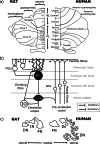Cerebellar Prediction and Feeding Behaviour
- PMID: 36121552
- PMCID: PMC10485105
- DOI: 10.1007/s12311-022-01476-3
Cerebellar Prediction and Feeding Behaviour
Abstract
Given the importance of the cerebellum in controlling movements, it might be expected that its main role in eating would be the control of motor elements such as chewing and swallowing. Whilst such functions are clearly important, there is more to eating than these actions, and more to the cerebellum than motor control. This review will present evidence that the cerebellum contributes to homeostatic, motor, rewarding and affective aspects of food consumption.Prediction and feedback underlie many elements of eating, as food consumption is influenced by expectation. For example, circadian clocks cause hunger in anticipation of a meal, and food consumption causes feedback signals which induce satiety. Similarly, the sight and smell of food generate an expectation of what that food will taste like, and its actual taste will generate an internal reward value which will be compared to that expectation. Cerebellar learning is widely thought to involve feed-forward predictions to compare expected outcomes to sensory feedback. We therefore propose that the overarching role of the cerebellum in eating is to respond to prediction errors arising across the homeostatic, motor, cognitive, and affective domains.
Keywords: Cerebellum; Feeding behaviour; Hunger; Reward; Satiation.
© 2022. Crown.
Figures



References
-
- Ito M. Neurophysiological aspects of the cerebellar motor control system. Int J Neurol. 1970;7(2):162–176. - PubMed
Publication types
MeSH terms
Grants and funding
LinkOut - more resources
Full Text Sources

